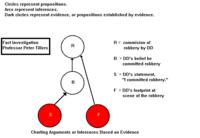 Mark P. Gergen, A Priest Responds to the Bean Counters: Leo Katz on Evasion, Blackmail, Fraud, and Kindred Puzzles of the Law (review essay), 22 Law & Soc. Inquiry 879, 890-891 (1997)(footnote omitted):
Mark P. Gergen, A Priest Responds to the Bean Counters: Leo Katz on Evasion, Blackmail, Fraud, and Kindred Puzzles of the Law (review essay), 22 Law & Soc. Inquiry 879, 890-891 (1997)(footnote omitted):Consider the case of price gouging for food, water, or other essentials during an emergency. Price gouging is not blackmail (or even common law duress), no matter how extreme the price demand or desperate the needs of the victim. This is a difficult case for [Leo] Katz, for the price gouger can be made to seem a swine if we make the facts extreme enough. On the other hand, the case of the price gouger is an easy one to explain under some other theories. James Lindgren would explain that the price gouger is not a blackmailer because he is bargaining with his own rights. Robert Nozick would explain that price gouging is not blackmail because, on balance, the victim is better off for having the opportunity to buy necessities from the price gouger. But Katz's theory better describes our feelings about the price gouger than do these other two theories because it expresses our unease about the price gouger's behavior. Katz tells us that the question finally turns on whether the price gouger is committing a sufficiently grave immorality, and while from some moral perspectives he is not acting immorally (Lindgren's and Nozick's theories are evocative of some of the reasons), from other moral perspectives he is.See also Gregory R. Kirsch, Hurricanes and Windfalls: Takings and Price Controls in Emergencies (Note), 79 Va. L. Rev. 1235, 1236-1237 (1993)(footnotes omitted):
... Hurricane Andrew provides a "disaster context" for this Note's inquiry into the rules of price controls, emergency takings, and just compensation, and whether the rules encourage and facilitate effective disaster relief. Andrew struck South Florida on August 24, 1992, with 150 mph winds, destroying more than 60,000 homes and leaving as many as a quarter of a million people homeless. The victims' need for food, water, home-repair materials, and other necessities exceeded available supplies. The destruction of much of the public and private infrastructure exacerbated the shortages. As microeconomic price theory predicts, established merchants and opportunistic entrepreneurs began charging sharply higher prices. For example, sheets of plywood, each priced at eight or nine dollars before the hurricane, were selling for as much as sixty dollars per sheet after the hurricane and milk was selling for up to six dollars per gallon. To combat this "price gouging," state and local officials enacted emergency laws prohibiting sellers from charging more than prehurricane prices. Four days after Andrew passed over South Florida, the federal government sent in troops to provide food and shelter.When disasters such as hurricanes strike, most Americans expect the government to intervene where markets fail to provide basic necessities. In this century, the federal government has enacted emergency price controls during three wars, during a period of high inflation, and during periods of turmoil in the petroleum markets. The federal government also conducted major takings programs during both World Wars to obtain the materiel necessary for the prosecution of war.
When prices rise quickly, price controls are an appealing "quick fix." But it is well known that price controls are likely to result in shortages, queues, and black markets. Because price controls may not be an effective solution to market failures, the government may choose instead to buy or take (i.e., requisition) needed goods and distribute them to the public (or, as in wartime, consume them itself). Thus, takings and price controls are alternative modes of emergency market intervention.

No comments:
Post a Comment